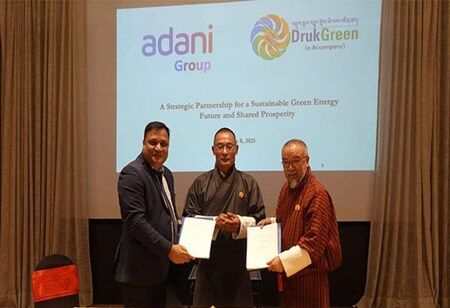
Adani Group Inks MoU with Druk Green Power Corporation

 According to reports, the Adani Group announces that the company has signed a Memorandum of Understanding (MoU) with Druk Green Power Corporation (DGPC) to develop 5,000 MW of hydropower projects in Bhutan.
According to reports, the Adani Group announces that the company has signed a Memorandum of Understanding (MoU) with Druk Green Power Corporation (DGPC) to develop 5,000 MW of hydropower projects in Bhutan.
The MoU was executed in Thimphu by DGPC’s MD Dasho Chhewang Rinzin and Adani Green Hydro Ltd’s COO (PSP & Hydro) Naresh Telgu, with Bhutan's Prime Minister Dasho Tshering Tobgay, Minister for Energy and Natural Resources Lyonpo Gem Tshering, and other high-ranking officials in attendance.
This MoU enhances the existing collaboration for the 570/900 MW Wangchhu Hydropower Project, where DGPC will maintain a controlling 51 percent share, while Adani will possess 49 percent.
“This partnership reflects our deep commitment to developing clean energy infrastructure that enhances regional energy security,” says Naresh Telgu, COO (PSP & Hydro), Adani Green Hydro Ltd.
Dasho Chhewang Rinzin, MD DGPC, says, “This strategic partnership with Adani will further strengthen our very strong engagement with the Government of India in harnessing Bhutan’s abundant hydropower resources, which is considered the cornerstone of the exemplary and friendly relations between our two countries. We look forward to taking this partnership forward with Adani and learning from their huge successes across the globe.”
Also Read: Top 7 Women Leading the Way for Clean Energy Transition
In another milestone, DGPC and Adani also signed the Shareholders’ Agreement for the Wangchhu Project, indicating notable advancement in their joint efforts to promote Bhutan’s hydropower industry.
This effort is also in line with Bhutan's Renewable Energy Roadmap, which targets an extra 20,000 MW of generation capacity by 2040.
The Adani Group firm possesses an operational capacity of 17.55 GW, which it plans to elevate to 30.67 GW by the year 2030. In the private sector, its growth in capacity will be the greatest. In the public sector, the state-owned NTPC aims to expand its thermal power capacity by 30 GW by 2032, in addition to the previously planned 26 GW.